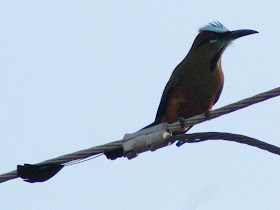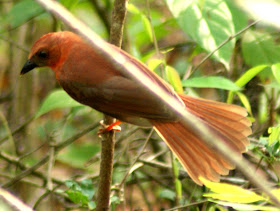Last month I got the chance to spend a couple of days in Playa del Carmen, on the Caribbean coast of the Yucatan peninsula in Mexico. I'd been to Playa a couple of times before but was surprised by how much development had taken place in the town and all along the "Riviera Maya" since my last visit five years ago.
I arrived in the evening and was out and driving a rental car south towards Tulum by 5:15 the next morning. My first destination was the Mayan archeological site of Coba, which is also supposed to be a very good birding site. I wanted to get there before the place was swamped by busloads of tourists and, thanks to a newly-improved road west from Tulum, I arrived before 7:00. As the site doesn't open until 8:00, I spent some time exploring the edge of the nearby lake and then the site's parking lot.
Out on the water there was what looked like a large, perhaps 6-foot-long, iguana.

The lakeside had several familiar birds: Great Egret, Double-crested Cormorant and Blue-winged Teal.
In the parking lot, too, I started off with familiar birds: male Great-tailed Grackles were busy calling and displaying.

Then I spotted a couple of slightly more exotic birds: Couch's Kingbird and Great Kiskadee.
My final sighting before being allowed into the ruins was much more exciting - but I'll tell you about that at the end of this posting!
For the first 90 minutes or so, I seemed to have the place almost to myself, except for birds and mosquitoes.
One of the great attractions of Coba is that the area hasn't been cleared and so the many ruined buildings are scattered here and there amidst thick jungle. This gives you the illusion that you are exploring rather than just sightseeing. Although my purpose on this visit was birding, I couldn't resist taking a couple of photos of the ruins.



As I walked the trails, I could hear birds all around me but getting to see them was a lot tougher. My visit followed what I suspect is the normal pattern of jungle birding: long stretches of birdless time interrupted by brief bursts of frantic bird activity.
After 15 minutes, I was lucky to come across one busy patch of undergrowth that yielded quick views of a Brown Jay, a Red-crowned AntTanager and a Grey-collared Becard.
Then the patch erupted in the most amazing noises as a couple of Squirrel Cuckoos moved through it.

A little later and beside a ruined temple, I spotted a Roadside Hawk. Unfortunately, he also spotted me and quickly disappeared.
Then another burst of activity turned up Melodious Blackbird, Red-billed Pigeon, Yellow-green Vireo and Rose-throated Becard, all birds that were new to me.
Twenty minutes later, I stopped to watch an Altamira Oriole feeding in a tree.


Nearby I had views of some more familiar birds - Black-throated Green Warbler, Chestnut-sided Warbler and Indigo Bunting.
Further down the trail I came across a Northern Waterthrush.

One thing that surprised me was the lack of wildlife other than birds. In three hours I had seen only one lizard.

Apart from mosquitoes, insect activity seemed very low also, although there were huge termite nests in many of the trees.

I did see a few butterflies but only one stayed still long enough to photograph.

By 9:45 the buses had arrived and the place was starting to swarm with visitors. So I headed back to the car, passing a Hooded Oriole and more Yellow-green Vireos on the way.
My final sighting at Coba was a very striking 3-foot-long lizard standing quietly by the main trail as groups of noisy visitors passed by.

It was 10:00 a.m. when I got back on the road, heading back towards Tulum and then south to Muyil, a much smaller and less well-known archeological site. I wouldn't get there until 11:00 or later, by which time the temperature would be in the 90s and most bird activity would probably have died down. However, Deanne and I had really liked Muyil when we visited it some years earlier - and I was fairly sure that I would have the site pretty much to myself.
The Best Sighting at Coba
I mentioned earlier that I had an exciting sighting in the Coba parking area. It was a Turquoise-browed Motmot, the first Motmot I had ever seen and a bird with a truly amazing set of tail feathers.

 .
.









Wonderful photos Jeff. I'm sure it was tricky actually getting pics in that jungle. Looks like you had a great morning of birding.
ReplyDeleteI don't know which is harder - photographing jungle birds in Mexico and Costa Rica or photographing warblers in trees and undergrowth in Texas.
ReplyDelete